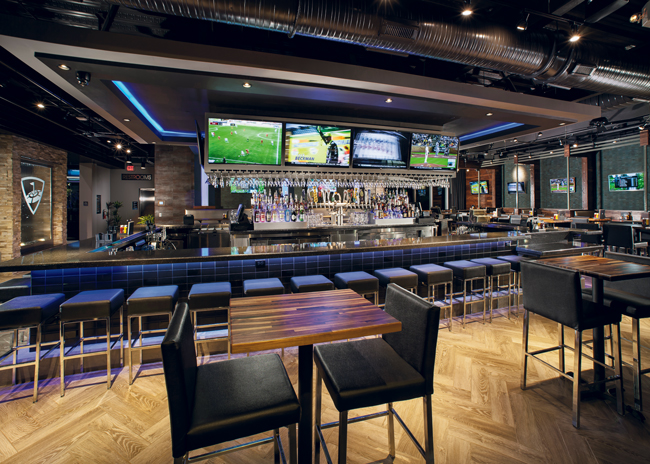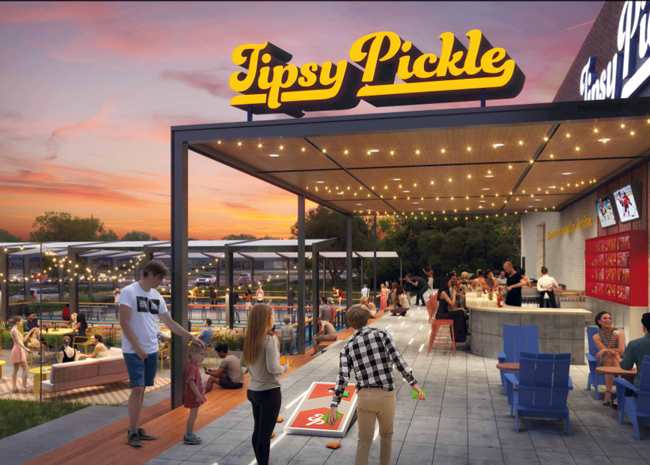Remember the explosion of food and gaming venues pre-pandemic where you could have dinner and throw darts or axes or play a little ping-pong? Well, after a little COVID-induced hiatus, “eatertainment” spots are back, baby!
 Photo courtesy TopgolfAt least, the data indicates as much. According to Datassential’s “What’s New With Eatertainment” report released in June 2024, 52% of consumers planned to visit eatertainment venues more often or the same amount in the next year, while 38% said they’d hit up barcades more often if available in their area.
Photo courtesy TopgolfAt least, the data indicates as much. According to Datassential’s “What’s New With Eatertainment” report released in June 2024, 52% of consumers planned to visit eatertainment venues more often or the same amount in the next year, while 38% said they’d hit up barcades more often if available in their area.
“Eatertainment establishments are on the upswing, with new concepts continuing to pop up,” Datassential’s report states. Established chains “are regaining their footing and planning new openings while new kids on the block such as Chicken N Pickle and Smash Park are looking to make their mark on the segment with pickleball-centric venues.”
Venues combining food and entertainment are nothing new — Chuck E. Cheese opened in the ’70s, Dave & Buster’s in the ’80s, and then there are casinos that have been around for even longer. But in this latest wave of gaming and eating venues, golf concepts like Topgolf and Puttshack and Puttery fill and boost this segment, along with other concepts that offer pickleball, bocce ball, baseball (Home Run Dugout), and even surfing (Goodsurf).
So, why the quick revert to these places? “Consumers are craving experiences and connections after a long drought and eatertainment venues fill the bill,” says Spencer Ressa, a designer with JME Hospitality. “They offer a differentiator from traditional restaurants and create those experiences diners want today.”
These operators have their work cut out for them; high-quality food and beverage are the key to success. According to Datassential, 32% of consumers say new and better food options would motivate them to visit an eatertainment venue.
Small Format, Big Impact
When it comes to eatertainment clients, the name of the game for Ressa is helping them save a little extra cash on build-out but laying out the reality that these places require a good amount of investment.
 Tipsy Pickle’s first location will include indoor and outdoor pickleball courts, a full-service restaurant and multiple bars. Images courtesy of Tipsy Pickle“We’re being asked to analyze how some of these places are being built and where they can save money,” Ressa says, noting that his team will look at construction costs and design the most efficient kitchens possible without over-equipping.
Tipsy Pickle’s first location will include indoor and outdoor pickleball courts, a full-service restaurant and multiple bars. Images courtesy of Tipsy Pickle“We’re being asked to analyze how some of these places are being built and where they can save money,” Ressa says, noting that his team will look at construction costs and design the most efficient kitchens possible without over-equipping.
More recently, Ressa worked with design-build construction company ARCO/Murray to help Topgolf roll out a new format for smaller markets as a way to continue to expand across the country after tapping out the bigger markets. ARCO/Murray also works with such growing eatertainment clients as Puttshack, F1 Arcade, and the aforementioned Goodsurf and Home Run Dugout.
“The main goal is to innovate the kitchens so they can use the least amount of space possible and require less labor but can still maintain high volumes,” Ressa says. “I often encourage possibly going ventless and using multiuse pieces like high-speed ovens, automated fryers and combis and changing up cooking operations to maintain high throughput in smaller formats. These pieces are also highly programmable, and we work with [the client] to make sure the programming comes from corporate so it’s consistent across the board. All this helps us prove that it’s worth it to invest in this type of equipment. The good news is that [these clients] are asking for help and want to look at different ways to build kitchens.”
Innovative design also helps enhance efficiencies and reduce costs. “If we put in a chef’s counter, we only want one connection versus excessive wiring and piping,” Spencer says. He explains that he also focuses on ergonomics and flow in and out of the kitchen to accommodate high-volume production.
The Pickleball Pandemic
Pickleball has taken over the tennis community — literally. Check out any traditional tennis court these days and you’re likely to see a pickleball net set up. This racquet-based sport has amassed quite the cult following, and now gyms, country clubs and hospitality companies are taking advantage of the revenue-generating opportunity.
 According to Datassential, while only 2% of consumers have visited a pickleball concept in the past year, 5% of consumers say they plan to visit one in the upcoming year, showing there’s an opportunity for operators to capitalize on this growing space.
According to Datassential, while only 2% of consumers have visited a pickleball concept in the past year, 5% of consumers say they plan to visit one in the upcoming year, showing there’s an opportunity for operators to capitalize on this growing space.
Tipsy Pickle announced plans to open its first location, a nearly 40,000-square-foot facility in Charlotte’s Camp North End that features indoor and outdoor pickleball courts as well as a full-service restaurant and multiple bars. Conceptualized by local entrepreneurs Mike Salzarulo and Tanner Brooks and designed by Southwick Architecture + Interiors, the concept features nearly 26,000 square feet of interior amenities including four pickleball courts, a gaming area, two golf simulators, ping pong tables, arcade games, pool tables, tic tac toe, darts and shuffleboard. The 10,000-square-foot outdoor space features two more pickleball courts and plenty of patio seating — all set before an ’80s video game backdrop.
“Pickleball is huge right now,” says Thomas Ivy, a senior project manager with Swinerton, the general contractor on the project. “This will be the first Tipsy Pickle location opening by the end of the year and featuring a full-scale commercial kitchen serving lunch and dinner during the week and on weekends with a Tex-Mex main restaurant on the first floor, a mezzanine-level bar and outdoor bar alongside pickleball courts.”
Though the official kitchen design and equipment were still in the works at press time, Ivy says the main kitchen would be mostly closed from sight, save for a large expo station offering a peek at the back of the house, and include a traditional lineup of equipment procured by Deacon Foodservice.
From a building standpoint, the greatest challenge of this adaptive reuse project so far has been from the ground up: meeting the requirements of Camp North End’s commitment to the Environmental Protection Agency’s Brownfields Program, which requires installation of a vapor intrusion mitigation system. “We need to report any soil disturbances to the North Carolina Department of Environmental Quality,” Ivy explains. “Preserving the existing warehouse structure while installing kitchen equipment and ventilation systems also requires detailed oversight and tailored engineering.”
Still, Ivy adds, “It’s been exciting because this project is different than traditional restaurants we have worked on. In the wake of the pandemic and with commercial offices trying to lure people back to offices, operators have had to find a differentiator, and right now, pickleball is a sport that’s taking off nationally. Even senior living communities are getting into the sport, which means it’s a pretty wide audience for hospitality.”
Kings of Gaming
When talking about eatertainment venues, one must not forget about the long haulers in this segment: casinos. Yes, casinos have long been a hotspot for gaming-plus-hospitality and a major revenue generator. But like their competition, they’ve gone through some changes, too.
 Kevin Banas, project manager, Cini-Little International, notes that the biggest change in the casino market has been the shift away from buffets. “Those extravagant buffets are great, but they make cost management for casinos difficult these days,” he says. “They’re also associated with a lot of waste, which is more concerning to consumers these days. And after COVID, people are more sensitive to the idea of a buffet as a potential vector for communicable diseases, even if they’re more perceived, as these operations have normal HACCP controls.”
Kevin Banas, project manager, Cini-Little International, notes that the biggest change in the casino market has been the shift away from buffets. “Those extravagant buffets are great, but they make cost management for casinos difficult these days,” he says. “They’re also associated with a lot of waste, which is more concerning to consumers these days. And after COVID, people are more sensitive to the idea of a buffet as a potential vector for communicable diseases, even if they’re more perceived, as these operations have normal HACCP controls.”
That said, it takes time and labor to stay on top of those HACCP protocols, including taking temperatures, replenishing food and maintaining cleanliness. This is why, amidst ongoing labor shortages, buffets also create challenges these days. As such, Banas says, casinos have moved toward more mini restaurants and retail outlets, all supported by a commissary-type production kitchen in the back of the house.
“You might have different stalls but not different operators with different kitchens like a food hall,” Banas says. “It’s much more manageable for the casino to have a bakery when everything is connected at the back, especially to control food costs as well as the noise, heat and movement associated with commercial kitchen operations.”
Ressa sees the growth of retail concepts in casinos that can stand alone as businesses but also connect to the back of the house. “I’m seeing more renovations moving toward grab-and-go-style options, especially on the casino floor,” he says. “It kind of reminds me of airports. And then all these outlets have self-checkout technology. This has been a way to offer high-end culinary options at a high pace but with reduced staff.”
When it comes to trending menus and food concepts, Banas says, “almost every casino I’ve worked on lately has or wants a noodle bar.” He explains, “They’re wildly successful and can be built apart from the casino to stand on their own. They can also serve a wide variety of menu items like pho, dim sum, sukiyaki and yakitori, char siu barbecue, and some even have full-fledged bubble tea offerings.”
Overall, says Ressa, “I think eatertainment will continue to do well” as a market segment. “People want to go out and do something while they eat and drink because they want that experience, and this spans all ages, from the very young to senior populations. I don’t see this slowing down anytime soon.”




